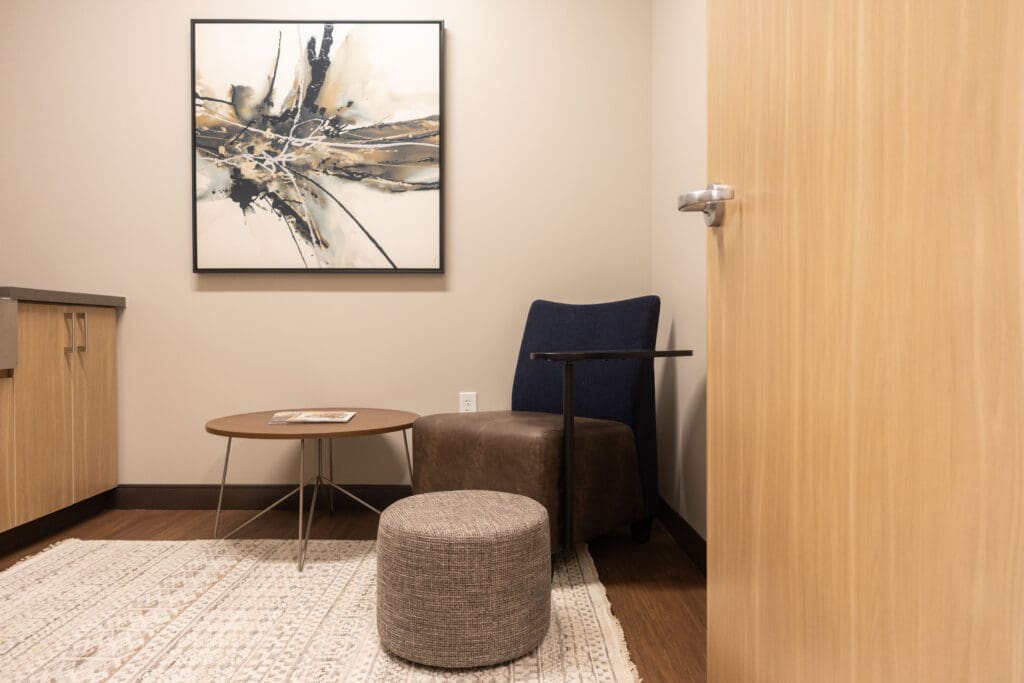Sometimes during the work day, you just need a minute.
Maybe you need a quick breather after a tense meeting. Or perhaps you need a moment to pause amidst a full day of work. The comfort of a place to go for a little peace and quiet is something many workers need and have come to expect from their workplaces.
Designing Restful Solutions
Thankfully, many workplaces and workspaces recognize the need to provide quiet spaces. Employers are now creating rooms that can serve many different needs, such as a pumping parent, the headache-plagued worker, or a person needing privacy to handle something personal during the workday. Known as “respite rooms,” they offer space for people to seek a brief refuge. Some rooms are designated for specific purposes–for instance, a mothers’ room is primarily for pumping–but ultimately all respite rooms are a spot to get away from the hustle and bustle of the modern workspace.
“Initially, these started as nursing rooms,” explained Jolynn Kaldor, a Workspace Expert at InterOffice. “But now there’s more emphasis on wellness–designating the space as somewhere to get away from the busyness of the day for 10-15 minutes.”

As part of their work at InterOffice, the Workspace Experts are becoming more and more familiar with the needs of and approaches to making respite rooms.
“It’s about finding out how people want to use them,” Jolynn said. “We ask what employers envision people doing in this room. For example, do they want to recline in a chair, rock in a chair, or sit in a stationary chair?”
Using that information, the space is crafted to achieve those ideas. Each respite room is highly customizable. While one office may need lush carpets and moody lamps, another may want natural light and light wooden finishes. Luckily, with InterOffice’s 3D modeling offerings, clients are able to see what they’re getting long before an order is placed.
InterOffice can design rooms to be an extension of the organization’s brand if folks are interested in continuity within their space. However, clients aren’t limited by those brand guidelines. These rooms can feel like extensions of the brand and the company, or they can feel like mini-escapes while still fitting cohesively into the established space. It’s the finishing touches that InterOffice makes that keep the spaces connected.
Healthy and Happy Employees
Further, investing in a respite room can help retain employees while helping them maintain their mental and physical health. Whether it’s a quick cat nap or a comfortable spot to pump or a private space, these rooms provide employees opportunities and spaces to handle the more human aspects of life.
“People can use the respite room however they’d like to,” Jolynn said. “It’s nice for people to have a space to go.”
Respite spaces are an investment in the workforce. Employees seek out excellent amenities, so these spaces quickly become a high-return investment, helping companies retain current and draw in new employees.
“Having an individual space like a respite room can offer employees a personal space to recharge during their workday,” Jolynn said.
The furniture pieces used in these respite rooms are also a big draw for employees. Pre-pandemic, many folks were used to sterile, stale office amenities that didn’t offer much in terms of comfort or respite. Organizations are making an effort post-pandemic to create more comfortable spaces, aiming to draw employees back from their work-from-home setups. The industry is calling it “resimercial,” a combo of residential and commercial approaches, using furniture and decor to create comfort with durability and professionalism.
“It makes the space more home-like,” Jolynn continued. “And it gives people the opportunity to feel comfortable enough to decompress.”
”Having an individual space like a respite room can offer employees a personal space to recharge during their workday.
Jolynn Kaldor




